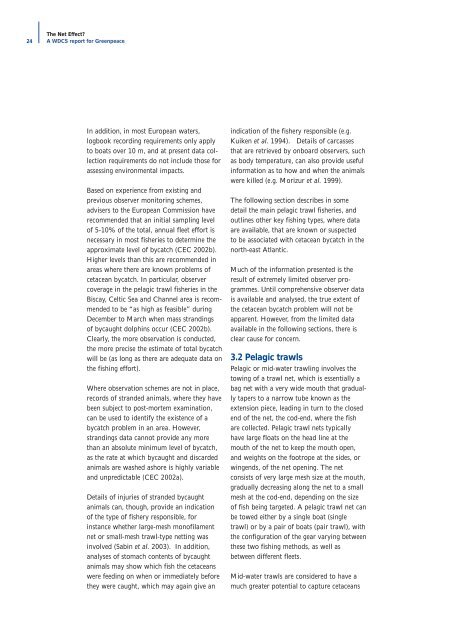The Net Effect? - Whale and Dolphin Conservation Society
The Net Effect? - Whale and Dolphin Conservation Society
The Net Effect? - Whale and Dolphin Conservation Society
You also want an ePaper? Increase the reach of your titles
YUMPU automatically turns print PDFs into web optimized ePapers that Google loves.
24<br />
<strong>The</strong> <strong>Net</strong> <strong>Effect</strong>?<br />
A WDCS report for Greenpeace<br />
In addition, in most European waters,<br />
logbook recording requirements only apply<br />
to boats over 10 m, <strong>and</strong> at present data collection<br />
requirements do not include those for<br />
assessing environmental impacts.<br />
Based on experience from existing <strong>and</strong><br />
previous observer monitoring schemes,<br />
advisers to the European Commission have<br />
recommended that an initial sampling level<br />
of 5-10% of the total, annual fleet effort is<br />
necessary in most fisheries to determine the<br />
approximate level of bycatch (CEC 2002b).<br />
Higher levels than this are recommended in<br />
areas where there are known problems of<br />
cetacean bycatch. In particular, observer<br />
coverage in the pelagic trawl fisheries in the<br />
Biscay, Celtic Sea <strong>and</strong> Channel area is recommended<br />
to be “as high as feasible” during<br />
December to March when mass str<strong>and</strong>ings<br />
of bycaught dolphins occur (CEC 2002b).<br />
Clearly, the more observation is conducted,<br />
the more precise the estimate of total bycatch<br />
will be (as long as there are adequate data on<br />
the fishing effort).<br />
Where observation schemes are not in place,<br />
records of str<strong>and</strong>ed animals, where they have<br />
been subject to post-mortem examination,<br />
can be used to identify the existence of a<br />
bycatch problem in an area. However,<br />
str<strong>and</strong>ings data cannot provide any more<br />
than an absolute minimum level of bycatch,<br />
as the rate at which bycaught <strong>and</strong> discarded<br />
animals are washed ashore is highly variable<br />
<strong>and</strong> unpredictable (CEC 2002a).<br />
Details of injuries of str<strong>and</strong>ed bycaught<br />
animals can, though, provide an indication<br />
of the type of fishery responsible, for<br />
instance whether large-mesh monofilament<br />
net or small-mesh trawl-type netting was<br />
involved (Sabin et al. 2003). In addition,<br />
analyses of stomach contents of bycaught<br />
animals may show which fish the cetaceans<br />
were feeding on when or immediately before<br />
they were caught, which may again give an<br />
indication of the fishery responsible (e.g.<br />
Kuiken et al. 1994). Details of carcasses<br />
that are retrieved by onboard observers, such<br />
as body temperature, can also provide useful<br />
information as to how <strong>and</strong> when the animals<br />
were killed (e.g. Morizur et al. 1999).<br />
<strong>The</strong> following section describes in some<br />
detail the main pelagic trawl fisheries, <strong>and</strong><br />
outlines other key fishing types, where data<br />
are available, that are known or suspected<br />
to be associated with cetacean bycatch in the<br />
north-east Atlantic.<br />
Much of the information presented is the<br />
result of extremely limited observer programmes.<br />
Until comprehensive observer data<br />
is available <strong>and</strong> analysed, the true extent of<br />
the cetacean bycatch problem will not be<br />
apparent. However, from the limited data<br />
available in the following sections, there is<br />
clear cause for concern.<br />
3.2 Pelagic trawls<br />
Pelagic or mid-water trawling involves the<br />
towing of a trawl net, which is essentially a<br />
bag net with a very wide mouth that gradually<br />
tapers to a narrow tube known as the<br />
extension piece, leading in turn to the closed<br />
end of the net, the cod-end, where the fish<br />
are collected. Pelagic trawl nets typically<br />
have large floats on the head line at the<br />
mouth of the net to keep the mouth open,<br />
<strong>and</strong> weights on the footrope at the sides, or<br />
wingends, of the net opening. <strong>The</strong> net<br />
consists of very large mesh size at the mouth,<br />
gradually decreasing along the net to a small<br />
mesh at the cod-end, depending on the size<br />
of fish being targeted. A pelagic trawl net can<br />
be towed either by a single boat (single<br />
trawl) or by a pair of boats (pair trawl), with<br />
the configuration of the gear varying between<br />
these two fishing methods, as well as<br />
between different fleets.<br />
Mid-water trawls are considered to have a<br />
much greater potential to capture cetaceans

















